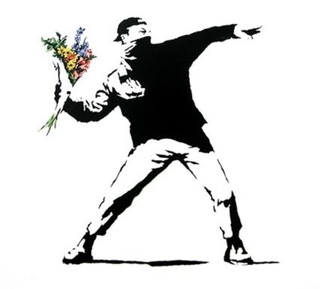

Due to his failure to admit his true identity in court, British street artist Banksy lost a copyright lawsuit against British greeting card company Full Color Black and his own trademark work Flower Thrower. This decision was made by the European Union Intellectual Property Office (EUIPO).
Banksy, a man of mystery, first painted Love Is In The Air (also known as Flower Thrower) in Jerusalem in 2005. The work depicts a young, half masked demonstrator, wearing a cap and throwing a bouquet of flowers that transformed from a petrol bomb. This graffiti piece portrays his support for the Palestinian perspective on the Israeli-Palestinian issue and has become a symbol of anti-war. In 2014, Banksy registered the painting as a trademark, and successfully released prints, dolls, and other works.
Through his studio, Pest Control Office, Banksy anonymously applied for a trademark (for Flower Thrower and other graffiti pieces) to the European Union and successfully obtained approval. Banksy had said that he welcomes reproductions of his works, for non-profit purposes. However, Full Color Black is suspected of printing Flower Thrower for sale without consent, which Banksy objected to and launched a two-year lawsuit against the company. Full Color Black filed an appeal against Banksy’s trademark registration in 2019, making the claim that Banksy had not used his registered trade for several years, and that the registrar’s form was only intended to prevent others from using works that he has allowed to reproduce. After the company filed a complaint, Banksy announced in October of 2019 that he would open Gross Domestic Product, an online store, so that he could sell its own creations. The online store also opened in response to the lawsuit and to prove that his trade was used for trading purposes.
In the end, the European Union Intellectual Property Office (EUIPO) ruled against Banksy, stripping him of his status as the copyright owner of the EU trademark. Under EU law, trademark holders are required to use trademark rights within five years, but EUIPO noted that Banksy did not sell goods or other items using registered images before the greeting card company challenged the trademark in 2019, and argued that he opened an online store only to deal with litigation. EUIPO’s office statement explained that Banksy’s intention was not to commercialize the trademark as a commodity, but to evade the law, a behavior that was dishonest on his part. This became one of the reasons for his failures. Another reason Banksy lost the case was that he remained anonymous from the beginning, and was unwilling to reveal his true identity. EUIPO said: “Banksy chose to remain anonymous, and in most cases, graffitied on other people’s properties without permission, rather than on canvas or on his own property.” Because his identity is unknown and he cannot be identified, it is not possible to determine who the creator is, without dispute. EUIPO’s judgement mentioned that Banksy had stated that: “the copyright was for the loser.” But he often relies on copyright, and competes with others in order to use an image.
